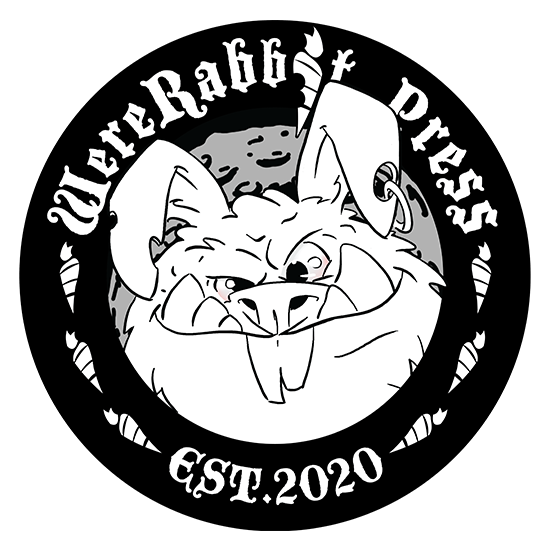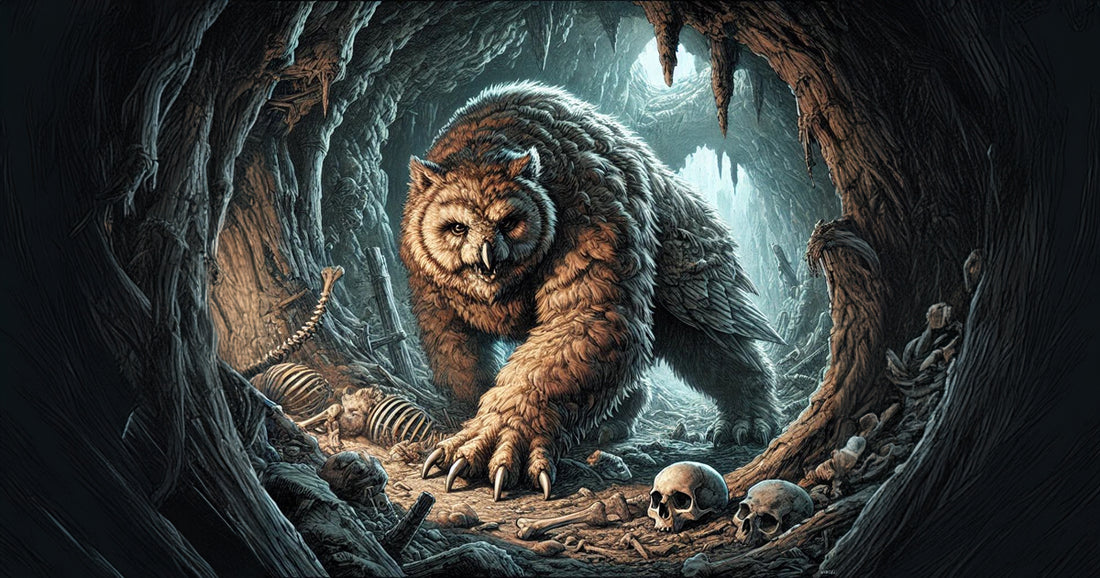The owlbear, a fearsome creature that combines a bear's ferocity with an owl's keen senses, roams the dark forests and dense wildernesses of the world. With its massive frame, sharp talons, and beak, this beast is a formidable predator that few dare to confront.
CREATURE LORE
The origins of the owlbear are shrouded in mystery and myth. Some say they were the result of a mad wizard's experiment, combining the essence of an owl and a bear through arcane means. Others believe they are a natural, albeit rare, species that has existed for eons. Tales of owlbears have been told for generations, their presence often marking the boundaries of untamed wilderness.
The owlbear's distinctive appearance, with its large, round head, sharp beak, and piercing eyes, combined with the robust build of a bear, has inspired many a cautionary tale among adventurers and common folk alike. Legends speak of ancient druids who revered these creatures as guardians of the forest, believing them to be sacred protectors of nature.
STRENGTHS and WEAKNESSES
Utilizing the owlbear's brute strength and keen senses can make it a formidable opponent in combat, especially in dense forests or dark environments where it can use stealth and ambush tactics. However, adventurers can exploit its limited intelligence and rage-driven behavior by setting traps, using distractions, and attacking from multiple angles to outmaneuver and defeat it.
STRENGTHS
Owlbears possess the robust build of a bear, allowing them to deliver devastating blows with their claws and beak. Their physical attacks can easily rend through armor and flesh alike. With the acute hearing and sight of an owl, owlbears are exceptional hunters, capable of detecting prey even in low light conditions or complete darkness. Known for their ferocity, owlbears attack relentlessly, making them relentless foes in combat. Their aggressive behavior can intimidate less experienced adventurers. The thick fur and hide of an owlbear provide natural armor, granting them resistance to physical attacks and making them difficult to wound.
WEAKNESSES
While dangerous, owlbears lack more intelligent creatures' cunning and strategic thinking. They rely on brute force and instinct rather than tactics, which clever adventurers can exploit. Owlbears are typically solitary creatures, rarely forming packs. This isolation can make them vulnerable to coordinated attacks from adventuring parties. The aggressive nature of an owlbear can lead to reckless behavior. They may charge into traps or be lured into disadvantageous positions by baiting their rage. Unlike other creatures that can form alliances or be tamed, owlbears are notoriously tricky to domesticate or negotiate with, limiting their adaptability in various situations.
SOCIAL STRUCTURE and PACK INFORMATION
Owlbears are generally solitary creatures, but their social behaviors, when observed, provide fascinating insights into their nature.
SOCIAL STRUCTURE
Owlbears typically hunt and live alone, marking and defending a large territory that provides ample food sources. Their solitary nature reduces competition for prey within their claimed area. During the mating season, owlbears may form temporary pairs. These pairs are fiercely protective of each other and any offspring they may produce. Once the young are capable of surviving on their own, the pair usually separates, each returning to a solitary lifestyle. Female owlbears exhibit strong maternal instincts, caring for their young with ferocious dedication. They will aggressively defend their offspring from any perceived threats, making them cautious adversaries.
PACK INFORMATION
Small groups of owlbears may be seen together on rare occasions, such as during a significant threat to their habitat or an abundance of prey. These gatherings are temporary and often tense as the creatures are not naturally inclined to cooperate. Encounters between owlbears frequently result in violent confrontations. Territorial disputes are common, with the dominant owlbear establishing control over the contested area. Owlbears communicate through a combination of vocalizations, body language, and scent marking. Their calls range from deep growls to eerie hoots, which can be heard echoing through the forest at night.
AVERAGE PLAYER LEVEL (APL) RECOMMENDATIONS
When incorporating owlbears into your campaign, it is crucial to consider the challenge they pose to adventurers of varying experience levels. Below are recommendations for encounters with owlbears based on the average player level (APL) of a party of four members.
TACTICS for GAME MASTERS
Using owlbears effectively in your campaign requires an understanding of their behavior and natural advantages. Here are some tips for Game Masters on incorporating owlbears into encounters and making the most of their fearsome presence.
ENVIRONMENTAL ADVANTAGES
- Dense Forests and Underbrush: Owlbears thrive in heavily wooded areas where they can use their stealth and keen senses to ambush prey. Set encounters in dense forests with plenty of cover and obstacles to enhance the owlbear’s predatory nature.
- Darkness and Low Light: Owlbears have excellent night vision, making them deadly in low-light environments. Use nighttime settings or dimly lit caves to give the owlbear an edge over adventurers.
- Nesting Grounds: Encounters near an owlbear’s nest can add layers of complexity. Protecting their young makes them more aggressive and unpredictable. Nests can also provide exciting terrain features, such as difficult terrain or narrow pathways.
COMBAT STRATEGIES
- Ambush Tactics: Owlbears often strike from hiding, using their stealth to close the distance before the party can react. Position the owlbear to ambush the party, exploiting surprise and confusion.
- Relentless Assault: Once engaged, owlbears fight with ferocity, focusing on a single target until it is down. They use their multi-attack to deal heavy damage quickly, forcing the party to react defensively.
- Hit-and-Run: If an owlbear takes significant damage, it may retreat into the underbrush to regroup before launching another attack. This can create a dynamic encounter where the party must track the owlbear while dealing with other environmental threats.
BEHAVIORAL TRAITS
- Territorial Aggression: Owlbears are highly territorial and will aggressively defend their domain from intruders. Use this trait to justify encounters and create tension as the party navigates through an owlbear’s territory.
- Protective Instincts: When near their nests or young, owlbears become even more dangerous. They will prioritize threats to their offspring and fight to the death if necessary.
- Unpredictability: Owlbears are driven by instinct rather than strategy, making their actions unpredictable. They might abandon a fight to chase easier prey or react violently to sudden movements.
STRATEGIES for ADVENTURERS
Facing an owlbear requires careful planning and tactical awareness. Here are some strategies from Thrain's perspective to help adventurers overcome these formidable creatures.
Preparation
- Scout Ahead: Gather as much information as possible about the terrain and the owlbear's movements before engaging. Knowledge of its nesting areas or hunting grounds can provide critical advantages.
- Use Bait: Owlbears are driven by their predatory instincts. Setting up bait can lure the owlbear into a trap or an advantageous position for the party.
- Prepare Defenses: Create barriers or use spells to hinder the owlbear’s movements. Spiked growth, entangle, and other area control spells can slow down or damage the creature as it approaches.
IN COMBAT
- Maintain Distance: Utilize ranged attacks and spells to whittle down the owlbear from a safe distance. Keeping out of its reach minimizes the risk of its devastating melee attacks.
- Focus Fire: Concentrate attacks on the owlbear to bring it down quickly. Dividing attention among multiple targets can allow the owlbear to deal significant damage.
- Use Distractions: Distract the owlbear with summoned creatures or illusions. This can create openings for the party to attack or reposition without taking damage.
EXPLOIT WEAKNESSES
- Target Its Instincts: Owlbears are driven by hunger and territoriality. Using illusions or noise can mislead them, giving the party opportunities to strike or escape.
- Capitalize on Rage: The owlbear’s aggressive nature can be its downfall. Lure it into traps or difficult terrain that can be more easily managed.
- Attack from Multiple Angles: Surround the owlbear to divide its attention and reduce the effectiveness of its attacks. This also provides opportunities for sneak attacks and flanking bonuses.
RETREAT and RECOVERY
- Have an Escape Plan: If the battle turns against the party, have a clear route for retreat. Owlbears may not pursue far if they feel their territory is no longer threatened.
- Healing and Buffs: Keep healers and support characters ready to heal injuries and provide buffs. Spells like cure wounds, healing word, and protection from energy can turn the tide of battle.
Rest and Regroup: After an encounter, take time to rest and recover. Owlbears rarely travel far from their territory, so use this to your advantage to heal and plan the next move.
Download Our Owlbear Quest
The Owlbear's Lair
Read it for Free or Get a PDF for Just a Buck
The Owlbear's Lair
In the village of Greenwood, fear grips the hearts of the villagers as a ferocious owlbear prowls the nearby forest, claiming victims and livestock alike. With disappearances mounting and the threat growing, the village elder, Rowan, has issued a desperate plea for brave adventurers. Will you venture into the dark, dense forest, track down the fearsome beast, and restore peace to Greenwood? The fate of the village rests in your hands.
A 2-Hour Adventure for 1st - 4th Level Characters
Encounter Overview
A ferocious owlbear has terrorized the local village of Greenwood. Villagers have gone missing, and the beast has been sighted near the outskirts of the forest. The village elder has called for brave adventurers to hunt down the owlbear and restore peace to Greenwood
Introduction
The adventurers arrive in Greenwood, a small village on the edge of a vast and dense forest. They are greeted by the village elder, a wise and weathered man named Elder Rowan, who explains the dire situation. Over the past month, several villagers have disappeared, and livestock has been slaughtered. The sightings of the owlbear have become more frequent, and the village is living in fear.


